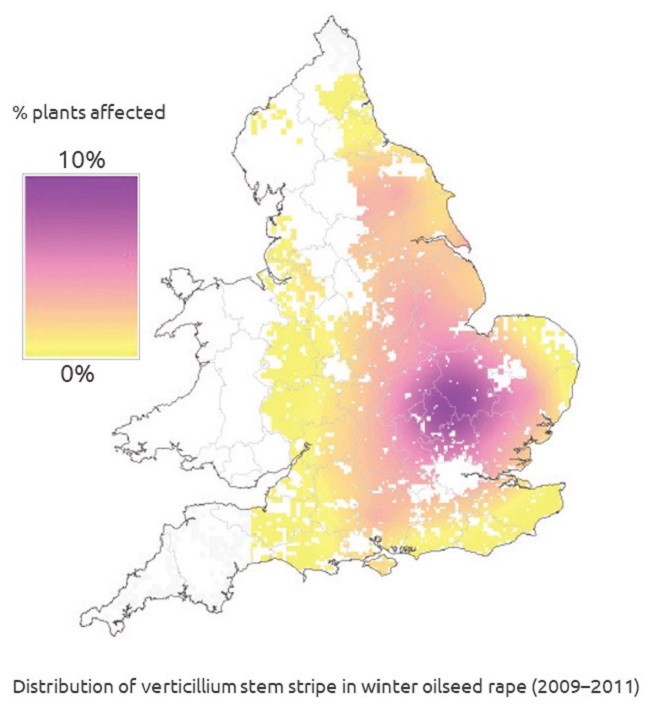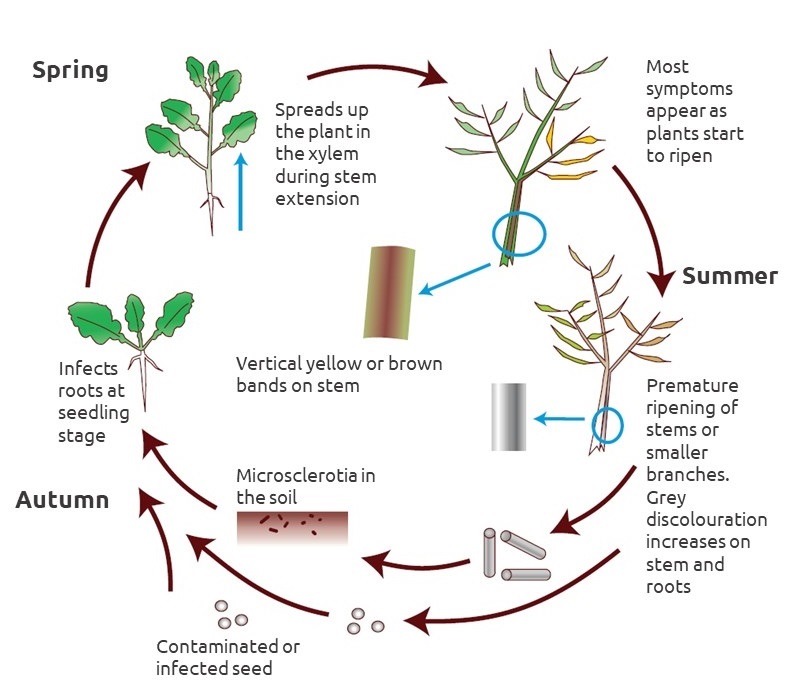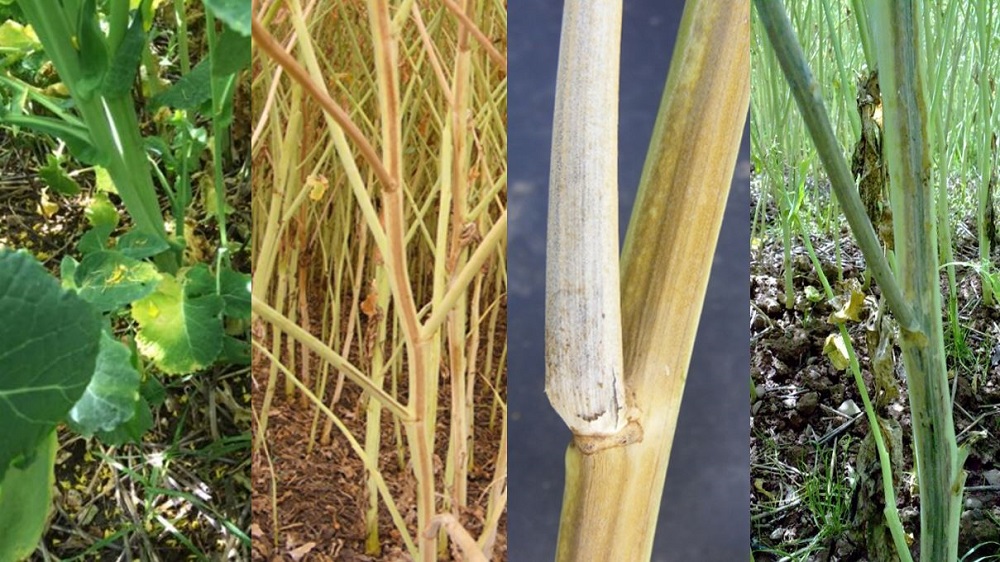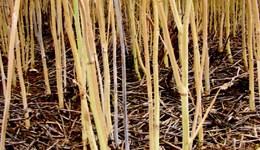How severe is verticillium stem stripe?
The pathogen that causes verticillium stem stripe – Verticillium longisporum – is sporadic. However, it is a persistent soilborne disease, so it can build in the soil, especially when susceptible hosts, such as vegetable brassicas, are regularly present.
Initially confirmed in England in 2007, the disease has now spread more widely. The most severely affected crops tend to be located in eastern England, with symptoms reported as far north as Yorkshire and west as Herefordshire.
Losses are variable, with trials in England recording yield reductions that ranged between 3% and 34%. Several weather and crop factors influence the extent of yield losses. For example, increased yield losses are associated with high temperatures and drought stress in the run-up to harvest. Usually, the greatest losses are associated with canopy collapse and seed shedding.
Initially known as ‘verticillium wilt’, it was renamed verticillium stem stripe in 2016, due to the absence of wilting symptoms in oilseed rape crops.

What are the symptoms of verticillium stem stripe?
Infection
The disease-infection cycle starts with microsclerotia. This compact mass of hardened fungal mycelium allows the pathogen to survive for over 10 years on plant debris in the soil (or with contaminated seed). Infection of the roots usually takes place during the seedling stage, at a relatively wide range of temperatures.
Colonisation
The fungus colonises the vascular tissue and upper plant during stem extension. Leaf yellowing may occur from April onwards, particularly on the lower parts of the canopy. Warm spring temperatures are associated with higher levels of visible symptoms. Yellow, followed by brown, vertical stripes occur on stems towards the end of June and early July.
Pre-harvest symptoms
As ripening progresses, stripes extend along the full length of the plant – from soil level into the upper branches – and become more visible. Usually, whole plants are affected but symptoms are occasionally limited to a few branches.
Scraping infected stem surfaces can reveal grey discolouration of the vascular tissue beneath the stripe. This becomes more obvious as the outer fleshy tissues of the stem dehydrate during ripening. During this final phase, the stem begins to shred, with masses of minute black microsclerotia visible in the tissue. Affected roots are grey in colour.
Severely affected plants ripen prematurely, with canopy collapse and seed shedding possible. Symptoms are also visible after harvest, on stubbles and crop debris.
Life cycle of verticillium stem stripe

Various symptoms of verticillium stem stripe

Left to right: Yellowing of half a leaf in mid-May. Classic stripes along the stem length in early July. Close-up of an affected branch (with clear distinction between the brown stripe and greener plant tissue). Manually scraped stem showing internal vascular staining.
Accurate diagnosis
Accurate diagnosis of verticillium stem stripe is not easy, especially where phoma cankers and stem lesions are present. Phoma stem cankers also produce black or grey lesions, brown stripes on stems and are associated with premature crop ripening. However, phoma lesions are usually only several centimetres long, tend to originate at a point where a leaf was attached to the stem and do not extend up the entire length of the main stem. Often, they also contain distinctive pycnidia that produce pink spore exudates.
Phoma leaf spot and stem canker management
Managing verticillium stem stripe risk
Monitoring
Inspect crops for symptoms, especially in the run-up to harvest.
Hygiene
Do not save seed from diseased crops for resowing. Note: Infected dust may contaminate the outside of clean seed. Keep infected material segregated from clean material.
Rotations
Wider rotations (of at least 1 in 4) can help reduce soilborne disease risk. However, even longer periods between susceptible hosts may be required for persistent diseases, such as verticillium stem stripe.
Establishment
Optimise establishment conditions. Poorly established crops, or crops with poor rooting are at a higher risk of infection. As the pathogen is active at a wide range of temperatures, late sowing does not decrease the infection risk.
Varieties
The Recommended Lists (RL) 2024/25 onwards includes resistance information to this disease.
It followed nearly a decade of work to produce robust resistance data.
Based on a mean verticillium disease index (0–100 scale), there are significant differences in the occurrence and severity of verticillium stem stripe symptoms between varieties.
Read about the verticillium disease assessments and results (August 2023 news)
However, the RL 2024/25 data is associated with a large least significant difference (LSD) value of 12.6, which is problematic.
Only differences between variety means that are larger than the LSD are statistically significant at the 5% level –meaning the result is only likely to occur by chance fewer than 1 in 20 times.
Following conversations with our statistical partner BIOSS (Biomathematics and Statistics Scotland), it was decided we could not base the disease ratings based on the usual 1–9 scale. Instead, we mapped the 1–9 disease ratings to one of three disease-rating categories:
- Moderately resistant (MR)
- Intermediate (I)
- Susceptible (S)
The S and MR categories are significantly different from each other (at the 5% level).
If you think your field is at risk from verticillium stem stripe, use the winter oilseed rape recommended list to identify moderately resistant varieties and avoid the susceptible varieties.
Although data is currently limited for most varieties, data set robustness is likely to improve with successive editions of the RL.
Learn about the verticillium disease rating calculations (December 2023 news)



